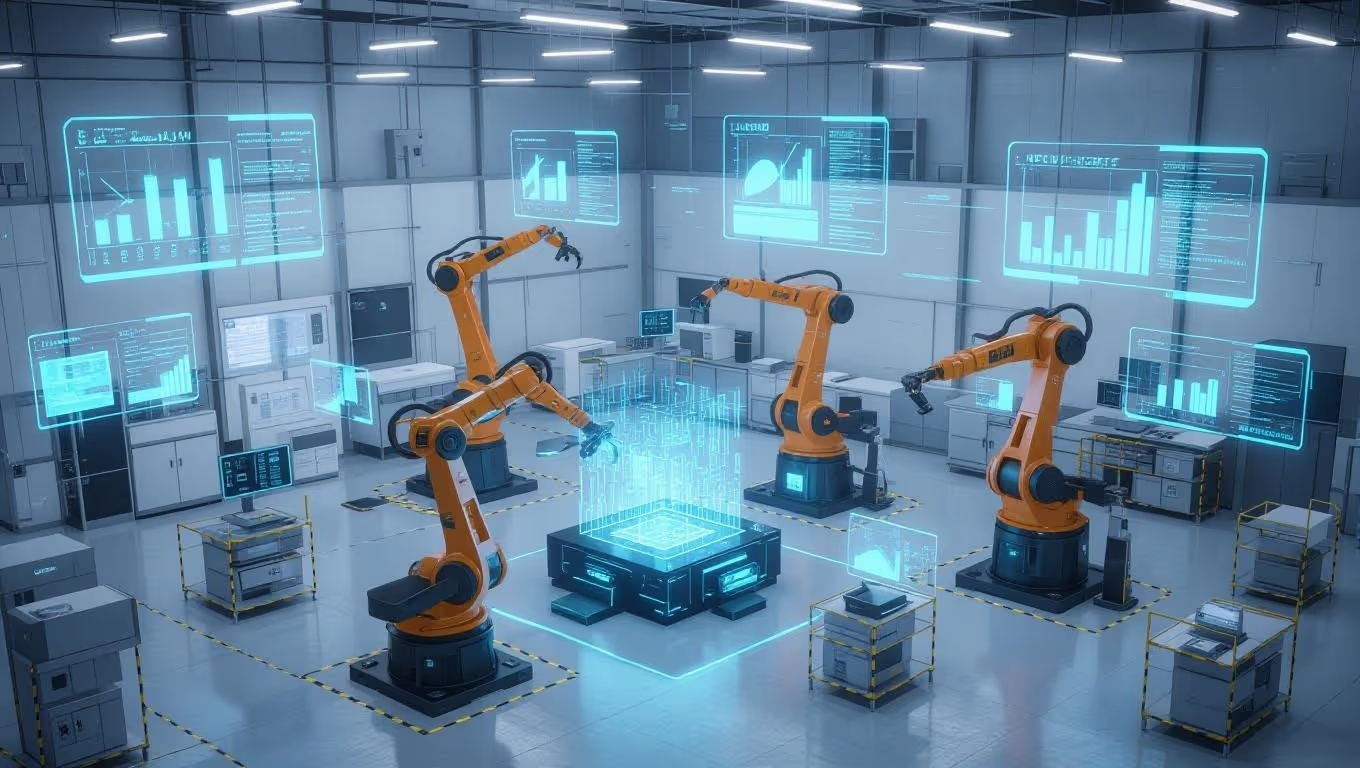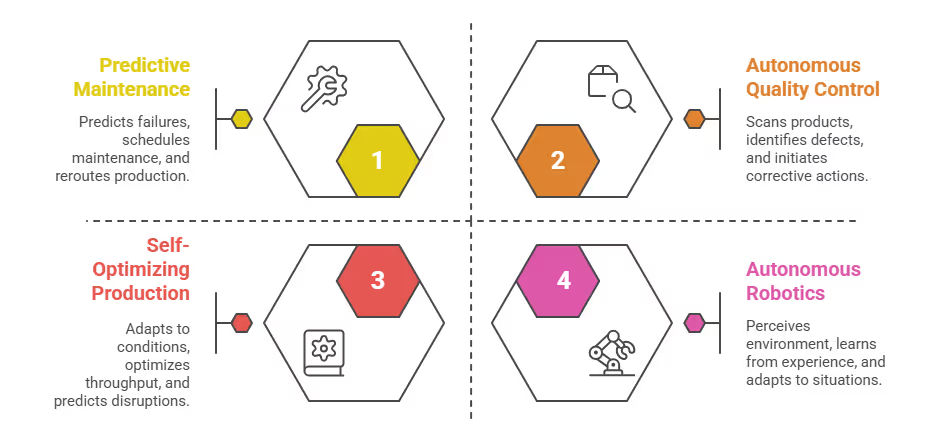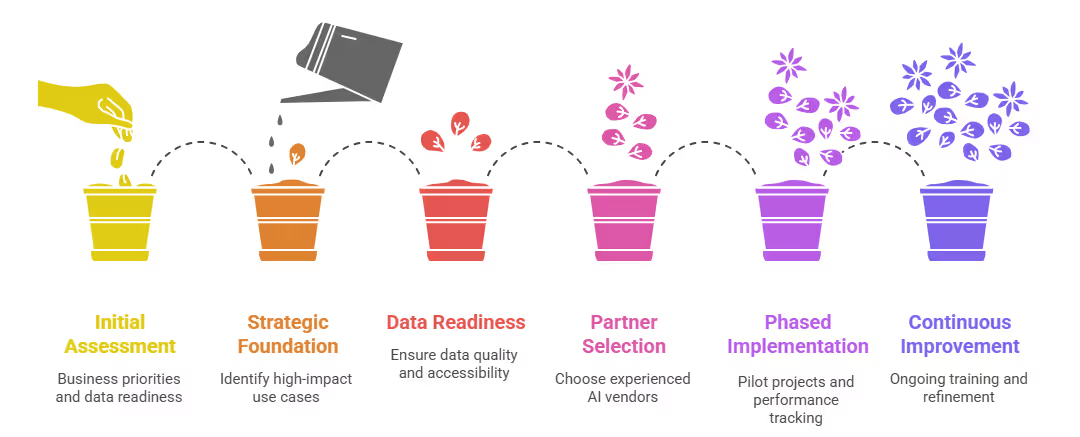Agentic AI Applications in Manufacturing | Future of Industry

Agentic AI Applications in Manufacturing: Transforming U.S. Factories with Autonomous Systems
When BMW's Spartanburg plant in South Carolina reduced production downtime by 40% through autonomous AI systems that predict equipment failures and self-optimize production lines, they demonstrated the transformative power of Agentic AI in manufacturing. As the founder of an AI agent development company that has implemented 35+ industrial AI systems across U.S. manufacturing facilities, I've witnessed firsthand how these autonomous systems are reshaping American manufacturing competitiveness. From Pennsylvania steel mills to Michigan automotive plants, Agentic AI is delivering 20-30% efficiency gains and revolutionizing how factories operate.
In this article, we'll explore the practical applications, implementation strategies, and tangible benefits of Agentic AI specifically for U.S. manufacturers looking to maintain their competitive edge in the global market.
Agentic AI enables fully autonomous manufacturing systems that perceive their environment, make real-time decisions, and take action without human intervention to optimize production processes, quality control, and supply chain operations. Unlike traditional automation, these intelligent agents continuously learn and adapt to changing conditions, making American factories more efficient, resilient, and competitive. Agentic AI enables manufacturing systems to make autonomous, real-time decisions, shifting operations from reactive to proactive.
What Makes AI "Agentic" - Beyond Traditional Automation
Core Capabilities That Define Agentic AI in Manufacturing
Agentic AI represents a fundamental shift from conventional automation and even traditional artificial intelligence in manufacturing environments. While working with U.S. manufacturers to implement these systems, we've identified six core capabilities that distinguish Agentic AI:
- Autonomous Decision-Making: Agentic AI systems can evaluate real-time data from sensors and production systems to make independent decisions without human intervention. For example, in steel manufacturing, our AI agents autonomously adjust oxygen flow in blast furnaces based on visual data to optimize combustion efficiency .
- Continuous Learning and Adaptation: Through reinforcement learning and neural networks, these systems evolve over time by learning from production environment feedback. One pharmaceutical client in Ohio saw their predictive maintenance algorithms improve accuracy by 27% over six months of operation .
- Context-Awareness in Dynamic Environments: Agentic AI excels at interpreting real-time data from diverse sources including IoT sensors, computer vision systems, and digital twins. This allows intelligent response to fluctuating production conditions or operational constraints.
- Goal-Oriented Problem-Solving: Rather than simply executing instructions, Agentic AI operates with specific objectives in mind, whether reducing operational costs, maximizing throughput, or improving product quality.
- Multi-Agent Collaboration and Coordination: In complex manufacturing environments, multiple AI agents work together, handling various tasks while coordinating to ensure system-wide harmony across production planning, inventory management, and supply chain optimization .
- Self-Governance with Minimal Human Supervision: These systems are designed to operate independently, detecting problems, exploring solutions, and implementing actions while maintaining traceability and compliance.
Cut Manufacturing Downtime by 20% with AI
Unplanned downtime costs manufacturers millions every year. Learn how AI agents can predict maintenance needs and keep your production lines running smoothly.
Start with a free consultation and see how we can help
How Agentic AI Differs from Traditional Automation
- Early automation: Machines were programmed to repeat specific tasks. They improved speed and consistency but could not adapt to changes.
- Traditional AI: Machine learning models introduced data-driven insights. These systems provided useful analysis but needed retraining, close monitoring, and human oversight.
- Agentic AI: A new stage where systems sense their environment, evaluate options, and act independently in real time.
- Adaptive decision-making: Uses reinforcement learning, computer vision, and digital twins to adjust processes as conditions shift.
- Outcome for manufacturers: Factories become more resilient, efficient, and capable of running with minimal human intervention, key traits of Industry 4.0 and smart manufacturing.
Agentic AI Applications in Manufacturing in USA

1. Predictive Maintenance and Self-Healing Equipment
- Unplanned equipment failures cost U.S. manufacturers approximately $50 billion annually in lost production time. Agentic AI transforms this paradigm by analyzing sensor data from machinery to predict failures before they occur.
- At a Pennsylvania automotive plant we worked with, Agentic AI systems now forecast equipment failures 72 hours in advance with 95% accuracy, automatically scheduling maintenance during low-production windows.
- These systems don't just predict failures, they autonomously initiate responses. When sensors detect abnormal vibrations in critical machinery, Agentic AI can automatically reroute production, order replacement parts, and generate work orders for maintenance teams without human intervention.
- This capability has helped our U.S. manufacturing clients reduce unplanned downtime by up to 70% and extend equipment life by 25%.
2. Autonomous Quality Control and Computer Vision
- Traditional quality control relies on manual inspection or basic automated systems that often miss subtle defects. Agentic AI-powered computer vision systems scan products in real-time with superhuman accuracy, identifying microscopic defects and inconsistencies.
- At a BMW Group manufacturing facility, an Agentic AI-driven visual inspection system automatically detects defects in automobile parts, dramatically improving flaw detection accuracy while minimizing manual inspection time.
- What makes these systems "agentic" is their ability not just to identify defects but to autonomously initiate corrective actions.
- When a defect pattern emerges, the AI can recalibrate production equipment, adjust parameters, or even temporarily halt production until the issue is resolved.
- This closed-loop quality control has helped electronics manufacturers in California reduce product defects by up to 90% while cutting inspection costs by 60%.
3. Self-Optimizing Production Lines and Supply Chains
Agentic AI enables production lines that dynamically adapt to changing conditions, demand fluctuations, and resource availability. These systems continuously analyze production data, market signals, and operational constraints to optimize throughput and efficiency.
In a recent implementation at a Midwest industrial equipment manufacturer, Agentic AI enabled:
- Dynamic rerouting of assembly tasks during machine outages
- Real-time adjustment of robotic arm trajectories for precision welding
- Energy consumption optimization based on utility pricing fluctuations
Similarly, in supply chain management, Agentic AI systems autonomously predict disruptions, negotiate with suppliers, and optimize logistics. Siemens AG adopted Agentic AI to optimize its complex supply chain, enhancing real-time inventory management. Their AI agents independently make supply chain decisions based on evolving demand signals, reducing inventory holding costs by nearly 20% and improving response times.
Transform Manual Processes Into Seamless Automation
Manual processes are slowing down your productivity. AI can automate routine tasks, reduce human error, and free up your team for more strategic work.
Ready to streamline your operations? Schedule a demo today.
4. Autonomous Robotics and Collaborative Systems
Traditional industrial robots require precise programming and controlled environments, limiting their flexibility. Agentic AI transforms robotics by enabling systems that perceive their environment, learn from experience, and adapt to new situations.
Fanuc utilizes Agentic AI for robotics in its factory automation solutions, creating autonomous robots that dynamically optimize tasks like material handling and assembly workflows, reducing human intervention by approximately 25% while enhancing factory productivity and reliability.
In U.S. manufacturing facilities, we're seeing rapid adoption of collaborative robots (cobots) powered by Agentic AI. These systems can safely work alongside human workers, taking on repetitive or strenuous tasks while adapting to changing production needs.
At a Texas electronics manufacturer, Agentic AI-powered cobots now handle component placement with such precision that they've improved assembly efficiency by 35% while reducing material waste by 22% .
Agentic AI in Manufacturing: Implementation Challenges
Despite its transformative potential, implementing Agentic AI in manufacturing environments presents specific challenges that require strategic approaches:
Data Integration and Legacy Systems
Many U.S. manufacturing facilities operate with legacy equipment and systems that weren't designed for AI integration. According to a McKinsey study, 70% of AI projects face obstacles related to data quality and infrastructure preparedness.
Overcoming this challenge requires:
- Strategic phased implementation starting with high-impact use cases
- Edge computing devices that can bridge legacy equipment and modern AI systems
- Digital twin technology to create virtual models of physical assets
Workforce Adaptation and Skill Gaps
Implementing Agentic AI requires both technical expertise and operational buy-in. Many manufacturers lack internal expertise in AI and machine learning, creating dependency on external partners.
Successful implementations typically include:
- Comprehensive upskilling programs for existing employees
- Change management initiatives to address resistance and build enthusiasm
- Cross-functional teams combining technology experts with operations personnel
Security and Compliance Concerns
Integrating autonomous systems into manufacturing operations raises cybersecurity concerns, particularly in regulated industries.
Manufacturers must implement:
- Zero-trust security architectures for connected industrial systems
- Regular security audits and vulnerability assessments
- Compliance-by-design approaches that build regulatory requirements into AI systems
Table: Leading Agentic AI Development Companies for U.S. Manufacturing
Developing and Deploying Agentic AI Systems in Manufacturing
Implementing Agentic AI in U.S. manufacturing requires more than technology adoption. It demands a structured roadmap that balances business priorities, data readiness, and operational execution.
Based on field experience, the following phased approach has proven effective:

Phase 1: Strategic Foundation and Use Case Identification
- Business Process Assessment: Conduct a comprehensive review of manufacturing workflows, from production lines to supply chains.
- Value Targeting: Pinpoint high-impact applications where Agentic AI can deliver measurable and visible results.
- Predictive maintenance to reduce unplanned downtime.
- Automated quality inspection to minimize defects.
- Inventory optimization to improve working capital.
- Early Wins: Select use cases with a clear return on investment to build confidence and organizational momentum.
- Change Readiness: Align leadership expectations and secure stakeholder buy-in before technical deployment begins.
Phase 2: Data Readiness and Infrastructure Assessment
- Data Audit: Evaluate what operational data exists, its quality, and how accessible it is across departments and systems.
- Gap Analysis: Identify missing or inconsistent data that could limit AI performance.
- Infrastructure Planning: Ensure computing environments, connectivity, and security standards are in place to support large-scale AI.
- Data Management Frameworks: Establish governance models for collection, cleansing, labeling, and continuous improvement of data streams.
- Silo Reduction: Address fragmentation by creating unified data pipelines across plants, suppliers, and enterprise systems.
Phase 3: Technology Partner Selection and Solution Design
- Partner Evaluation: Choose vendors or integrators with proven manufacturing AI experience, preferably in the company’s specific sector.
- Cross-Functional Teams: Form joint groups that include operations managers, plant engineers, data scientists, and IT leaders.
- Solution Tailoring: Ensure the AI system is not just technically advanced but also adapted to unique operational workflows.
- Risk Management: Evaluate compliance, cybersecurity, and integration risks early in the design process.
- Scalability Planning: Design for future expansion, avoiding bespoke solutions that cannot grow across multiple facilities.
Phase 4: Phased Implementation and Continuous Improvement
- Pilot Projects: Begin with small-scale, well-defined pilots to validate AI performance in real conditions.
- Performance Tracking: Establish metrics and dashboards to measure uptime improvements, quality gains, or cost reductions.
- Iterative Scaling: Expand successful pilots plant-wide or across facilities in controlled stages.
- Feedback Loops: Continuously retrain and refine AI models with new data to maintain accuracy as operating conditions evolve.
- Change Management: Provide ongoing workforce training and communication to ensure adoption at every level of operations.
- Long-Term Governance: Build in mechanisms for periodic review, compliance audits, and updates to keep systems aligned with both regulatory and business needs.
Successful Agentic AI deployment is not a one-time project but a staged journey. By aligning business goals, ensuring data readiness, selecting the right partners, and scaling with continuous improvement, manufacturers can unlock sustained competitive advantage.
Future of Agentic AI in U.S. Manufacturing
Agentic AI is set to redefine how American manufacturing operates over the next decade. Beyond incremental automation, it represents a shift toward intelligent, autonomous systems capable of learning, adapting, and making decisions in real time.
Several trends are shaping the path ahead:
1. Increased Factory Autonomy
- Lights-Out Manufacturing: By 2030, fully autonomous production environments are expected to emerge where Agentic AI supervises and controls end-to-end operations.
- Real-Time Adaptation: AI systems will dynamically adjust production schedules and workflows based on shifts in consumer demand, supply chain disruptions, or equipment status.
- Minimal Human Oversight: Human staff will play supervisory roles, stepping in only for exceptional cases such as safety incidents or regulatory interventions.
2. Advanced Human–AI Collaboration
- Division of Labor: AI agents will take on hazardous, repetitive, and precision-driven tasks, while human workers focus on innovation, system design, and complex problem-solving.
- Immersive Interfaces: Augmented and virtual reality platforms will allow seamless communication between humans and AI, enabling real-time monitoring and decision support.
- Workforce Evolution: Roles will shift from machine operators to knowledge workers, requiring upskilling in data analysis, system oversight, and digital tool usage.
3. Hyper-Personalized Manufacturing
- Mass Customization at Scale: Production lines will be reconfigured on demand to deliver tailored products without the delays of traditional retooling.
- Consumer-Centric Models: Industries such as automotive, electronics, and healthcare will gain the ability to meet individualized specifications profitably.
- Competitive Advantage: Manufacturers that master agile, AI-driven production will set themselves apart in markets increasingly driven by personalization.
4. Enhanced Sustainability Initiatives
- Autonomous Optimization: AI agents will independently minimize resource consumption by regulating energy, raw materials, and waste outputs.
- Circular Manufacturing: Systems will identify opportunities to reuse and recycle byproducts directly within the production cycle.
- Green Leadership: Companies leveraging Agentic AI will reduce costs while strengthening compliance with environmental regulations and reinforcing their sustainability credentials.
Agentic AI is not simply a tool for operational efficiency; it is becoming the backbone of a new industrial model. Factories of the future will be more autonomous, adaptive, sustainable, and consumer-driven, positioning U.S. manufacturing for global leadership in the next industrial era.
Case Study: Optimizing Assembly in a U.S. Automotive Plant
A major U.S. automotive manufacturer faced a significant challenge on one of its assembly lines. A specific sub-assembly process was prone to frequent bottlenecks and inconsistent quality. The company had traditional automation in place, but it was rigid and could not adapt to minor variations in components or a sudden surge in demand for a specific car model.
We partnered with them to deploy a multi-agent system for this specific section of the line.
The system included:
- A "Perception Agent" that used computer vision and sensors to monitor the component as it arrived. It could identify minute imperfections or variations.
- A "Planning Agent" that, based on the perception agent's findings, would autonomously adjust the robotic arm’s trajectory and force to compensate for the variation, ensuring a perfect fit every time.
- A "Coordination Agent" that communicated with the broader MES to update the production schedule in real-time if a component required more time or a re-work.
The results were transformative. The project led to a 40% reduction in re-work and eliminated the bottleneck entirely, as the system could now adapt to variables that previously caused the line to halt. This success is now being scaled across other facilities in the U.S.
The Future is Autonomous
The shift to agentic AI is the next logical step for the U.S. manufacturing industry. It's about moving beyond simple automation to truly intelligent, autonomous operations. The goal isn’t to replace people, but to build a new partnership between human ingenuity and artificial intelligence. By implementing these systems, U.S. manufacturers can not only cut costs and improve quality but also build a more resilient, agile, and competitive enterprise.
If you’re a U.S. manufacturer ready to explore how agentic AI can transform your operations, we can help. Our expertise in developing custom AI agents can help you identify the right starting point, build a solid data foundation, and implement a scalable solution that delivers real, measurable results.
Let’s build the factory of the future, together.

